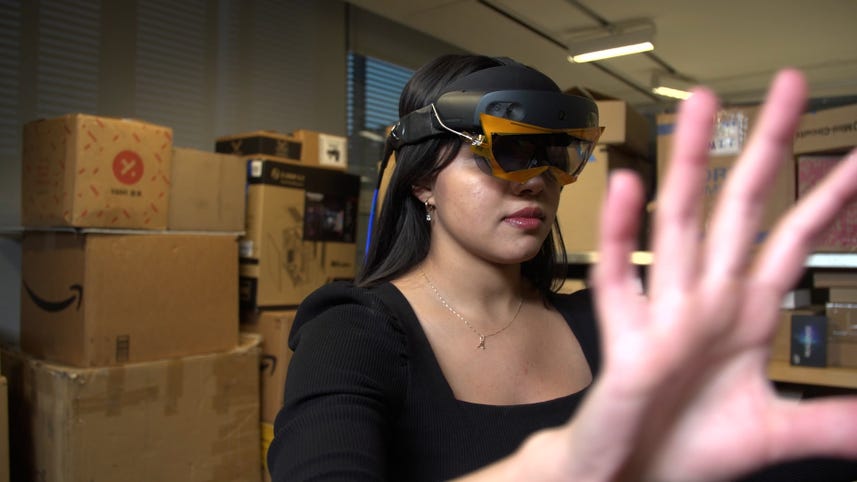
Speaker 1: X-ray vision might not be strictly for superheroes much longer thanks to a new application of a familiar technology. Augmented reality offers a layer of virtual content that usually goes on top of the picture of the world taken in by our eyes. But researchers at M I T are using AR to help us see beyond barriers and a kind of x-ray vision. They're calling X A R. We spoke to two members of the research team to find out how it works, how it might be useful, and what this kind of technology might [00:00:30] be able to show us in the future.
Speaker 2: So what we've made is actually a blueprint of how do you combine these wireless sensing and radio frequency sensing into a AR headset to see beyond the line site, for example, inside boxes behind the wall, and then it's able to visualize it to humans so that they can see and interact with what is actually impossible with our human sensors.
Speaker 1: Their prototype X [00:01:00] R system is built as an add-on to Microsoft's HoloLens, but researchers say it could be applied to other augmented reality systems down the line.
Speaker 2: The HoloLens itself has different cameras, different sensors already on it, and so we wanted to have something lightweight so that it wouldn't be cumbersome for the user. We also didn't wanna block any of the sensors on the camera itself, and we wanted to make sure that the HoloLens was still usable.
Speaker 1: The result is a flexible antenna that adds a sort of sixth sense to the HoloLens that allows it to [00:01:30] locate specific objects that are outside the wearer's line of sight as long as they're less than 15 feet away and marked with a commonly used item known as a radio frequency identifier or R F I D.
Speaker 2: This is an R F I D as you can see here. It's kind of, there we go, <laugh>. So RFIDs are extremely cheap. They're around two to 3 cents each. They're already deployed throughout the environment. They might be in your clothes, credit cards, et cetera. They're flexible, they're tiny. They're battery list. Have you seen movies that there's presumably [00:02:00] a sheep going in? There's someone with a mirror sending a message by shining the light of the sun. This is exactly Hannah RFI divorce. So there is an antenna environment sending signals, and then the R F I D shines back or doesn't shine back. And this is how it sends zero in one, zero in one. That's how it communicates. So they, that's why they do not need any battery because someone else is shining a light or a signal and it's just reflecting like a mirror. But something that our lab, uh, is unique for is that we [00:02:30] actually take it one step further and we localize these tags. So over the past couple years now, and actually our, our professors work that he kind of started was how do we localize these tags, uh, with centimeter scale accuracy?
Speaker 1: Researchers say that these R F I D tags offer more accuracy for less money than consumer Bluetooth trackers like the air tag with the added bonus that they never run out of battery. R F I D tags have been used previously to help a robot arm locate hidden objects as part of a project called [00:03:00] our Fusion.
Speaker 2: I was also the lead author on that project in our fusion. We were able to tell the robot how to move because it's a robot, it'll listen to you, it'll do what you want it to do. So it's much easier with a robot to tell it to go to specific location and take a specific measurements. But when you're talking with a human, even if you tell them do this, they might not listen to you. So it's a completely different problem.
Speaker 1: The end result is a custom HoloLens app the team made that provides the wearer [00:03:30] with directions to a specific item. The app also uses HoloLens hand tracking to offer a message of confirmation whether or not the correct item has been picked up. Possible applications for this technology include use in warehouses, shipping, retail, and other places where R FFI D tags are commonly used. However, researchers say the potential applications of this sort of technology go much farther
Speaker 2: Using radio frequency signals. You can see if someone is having heartbeat or someone is breathing. So we can think that in future, [00:04:00] we can enable these headsets to, for example, find missing people or injured people when a disaster happens. So if you are breathing or uh, having a heartbeat, your chest and your abdomen moves in by the reflection of the RF signals in the environment, you can detect it. So this can be done without actually any R F I D on the human body. It's interesting to see if we can enable this on a AR headset, maybe firefighters in the future, and the first responders can have it and they can [00:04:30] save people's life.
Speaker 1: As always, thanks so much for watching. I'm your host, Jesse Orle. See you next time with the fam.